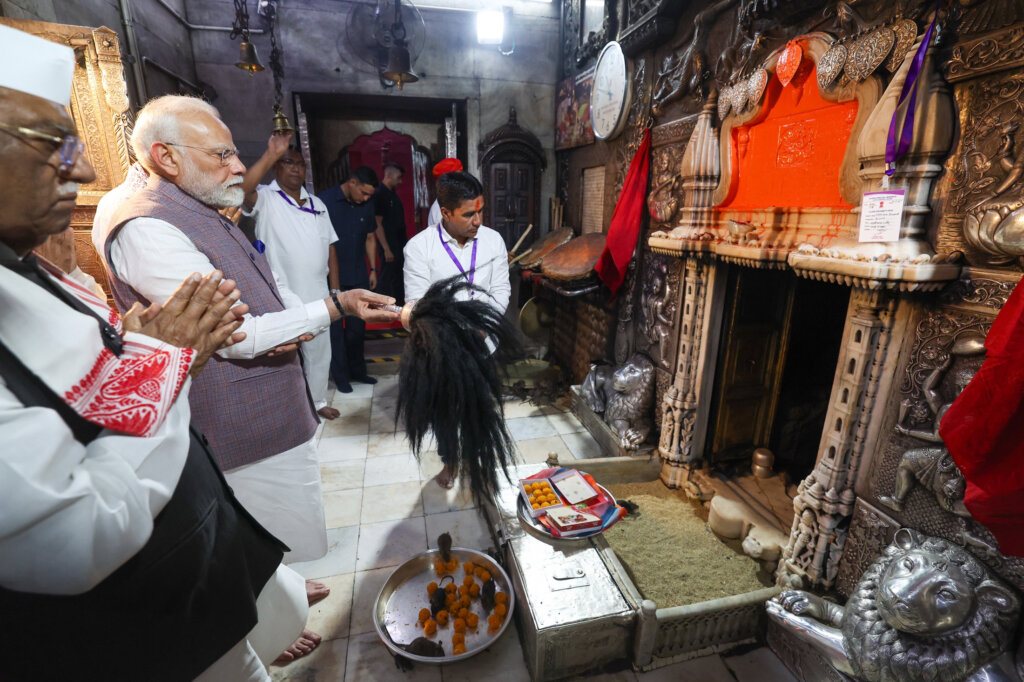
22-05-25 Bikaner : Prime Minister Shri Narendra Modi dedicated several development projects totaling Rs 26,000 crore in Bikaner, Rajasthan, and laid the foundation stone. Speaking during the event, Putin greeted the sizable crowd and acknowledged the noteworthy participation of those who joined online from 18 states and union territories. Several governors, chief ministers, lieutenant governors, and other public officials were there, he noted. The Prime Minister greeted all of the distinguished dignitaries and residents who were connected from all throughout the nation.

Shri Modi said he came to the gathering after asking Karni Mata for her blessings, highlighting how these blessings bolster the country’s determination to create a developed India. He emphasized the importance of development projects totaling ₹26,000 crore in furthering the nation’s prosperity, mentioning their inauguration and the laying of their foundation stones. He gave the people his congratulations for these revolutionary efforts.
The Prime Minister highlighted India’s commitment to modernization by highlighting the country’s continuing infrastructure transformation, pointing to the country’s tremendous improvements in roads, airports, trains, and railway stations during the previous 11 years. The Prime Minister said, “India is now investing six times more in infrastructure development compared to previous years, a progress that has captured global attention.” He mentioned several notable infrastructure projects throughout the nation, including the impressive Bogibeel Bridge in Assam in the east, the Sela Tunnel in Arunachal Pradesh, and the Chenab Bridge in the north. He mentioned the Atal Setu near Mumbai in western India and the Pamban Bridge, the country’s first bridge of its kind, in the south.
Shri Modi highlighted the launch of the Vande Bharat, Amrit Bharat, and Namo Bharat trains as representations of India’s increased speed and advancement while highlighting the nation’s ongoing efforts to upgrade its railway system. He said that Vande Bharat trains are currently operated on around 70 routes, providing distant areas with contemporary rail connectivity. He also highlighted the notable improvements in infrastructure over the previous 11 years, such as the installation of more than 34,000 kilometers of new railway tracks and hundreds of road overbridges and underbridges. He pointed out that safety has improved with the removal of unattended level crossings on broad gauge lines. Shri Modi also emphasized the current construction of India’s first bullet train project and the quick development of dedicated freight lanes to expedite cargo traffic. In addition to these initiatives, over 1,300 train stations are being modernized to enhance the traveler experience.
The Prime Minister emphasized that more than 100 of the upgraded train stations have been finished and are now known as Amrit Bharat Stations. He pointed out that social media users have seen how these stations, which are displays of regional history and art, have undergone a dramatic change. He cited notable instances, such as the Mandalgarh station in Rajasthan, which reflects the magnificence of Rajput customs, and the Thawe station in Bihar, which features Madhubani artwork and the spiritual presence of Maa Thawewali. The Sri Ranganatha Swamy temple serves as the inspiration for the Srirangam railway station’s design, while the Orchha railway station in Madhya Pradesh radiates the heavenly essence of Lord Ram. Begumpet station represents the Kakatiya dynasty’s architectural heritage, Tiruvannamalai station adheres to Dravidian architectural ideas, and Gujarat’s Dakor station honors Ranchhodrai ji. The Prime Minister emphasized that in addition to protecting India’s millennium-old legacy, these Amrit Bharat Stations act as engines for the expansion of tourism in all states, generating new job possibilities for young people. Since they were the real proprietors of this infrastructure, he urged the public to maintain the stations’ safety and cleanliness.
Shri Modi underlined that the thousands of crores being spent are directly benefiting workers, shopkeepers, factory employees, and those involved in the transportation sector, such as truck and tempo operators, and that government investments in infrastructure not only spur development but also generate employment opportunities and increase business activity. He pointed out that the advantages increase after infrastructure improvements are finished. Farmers can cut waste by using less expensive transportation to get their produce to markets. Expanded railway networks and well-maintained roadways draw in new businesses and greatly increase tourism. He emphasized that every household eventually benefits from infrastructure spending, with young people benefiting the most from new economic prospects.
Shri Modi pointed out that the thousands of crores being spent are directly benefiting workers, shopkeepers, factory employees, and those involved in the transportation sector, such as truck and tempo operators, and that government investments in infrastructure not only spur development but also generate employment opportunities and increase business activity. He pointed out that the advantages increase after infrastructure improvements are finished. Farmers can cut waste by using less expensive transportation to get their produce to markets. Expanded railway networks and well-maintained roadways draw in new businesses and greatly increase tourism. He emphasized that every household eventually benefits from infrastructure spending, with young people benefiting the most from new economic prospects.
The creative work of Maharaja Ganga Singh, who turned arid regions into lush fields. He emphasized the vital role that water plays in the region’s development, particularly in areas like western Rajasthan, Bikaner, Hanumangarh, and Shri Ganganagar. According to him, the administration is putting river-linking projects into action and working hard to finish irrigation projects. He emphasized how the Parvati-Kalisindh-Chambal Link Project will help several districts in Rajasthan, improving farmers’ agricultural prospects and the sustainability of the area.
